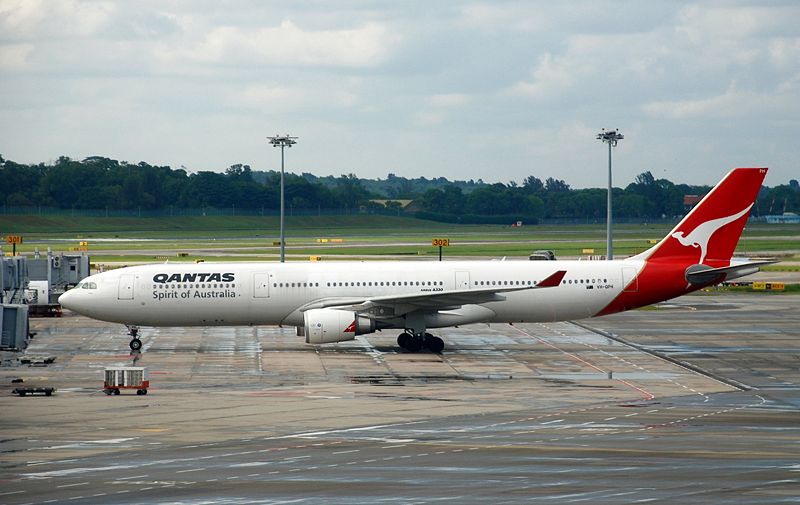Serious Injuries on a Qantas
A330 on 7 October 2008
7 October 2008; Qantas A330-300; Flight 72; VH-QPA; near Learmonth, Australia: The aircraf, twith 303 passengers and 10 crew members on board, was on a scheduled international flight from Singapore to Perth. While in cruise, the aircraft reportedly experienced some type of sudden and unexpected altitude change. The crew issued a mayday call before diverting the aircraft to the airport at Learmonth, near the town of Exmouth, about 1100 kilometers or 680 miles north of its intended destination of Perth.
About 36 passengers and crew members were injured, with over a dozen severe injuries. Reportedly, several occupants were slammed into the ceiling during the event. Most of the injuries were to passengers and crew in the rear of the aircraft, and at least one person was carried off the plane in a stretcher. About 13 of the most seriously injured were flown to Perth by four aircraft from the Royal Flying Doctor Service. One flight attendant was hospitalized with suspected head and spinal injuries. Other serious injuries included fractures, lacerations, and a concussion.
This wass the first significant passenger safety event for the A330. Qantas at the time had 15 A330 aircraft in its fleet, including 10 of the A330-300 model.

This was the second significant safety event for Qantas in 2008. On July 25, 2008 an exploding oxygen bottle blew a hole in the fuselage of a Qantas 747 en route from Hong Kong to Melbourne, causing a rapid decompression and forcing an emergency landing in Manila. No passengers were injured in that event.
Other significant safety events for Qantas in the last decade include a 2000 event in Rome involving the collapse of a 747 landing gear, and in 1999 a landing overrun in Bangkok severely damaged another Qantas 747.
In August 2008, the Civil Aviation Safety Authority of Australia conducted a review of Qantas safety and found no system-wide safety issues, but did recommend an audit of the airline's maintenance practices, including a full maintenance audit of one aircraft from three of the models flown by Qantas, the 737-400, 747-400, and 767-300. No maintenance audit was ordered for the airline's A330 fleet.
The Australian Transport Safety Bureau (ATSB) has released two interim reports about this accident, the first in March 2009 and the second in November 2009. The first interim report identified two significant safety factors. First, one of the air data computers provided incorrect data that was not detected by the aircraft systems. Second, the aircraft's flight control computers did not process some of the aircraft's attitude data in a specific situation.
The second interim report did not identify the cause of the October 2008 event, but detailed the safety actions that have been taken that would prevent a recurrence of the event, including modifications to the A330's primary flight control computer and changes in flight crew operational procedures.
The ATSB addressed the possible relationship between the October 2008 Qantas A330 event and the June 2009 crash of an Air France A330-200 (F-GZCP, Flight 447). Although both investigations are ongoing, the ATSB pointed out several key differences between the two events:
- The air data computers on the two aircraft were different models, and constructed by different manufacturers.
- The cockpit messages and maintenance fault messages from both flights showed a significantly different sequence and pattern of events, with the maintenance messages that were transmitted by the Air France aircraft prior to the accident showing inconsistencies between the measured airspeeds and the associated consequences on other aircraft systems. No such messages were recorded by by the Qantas aircraft.
- The airspeed sensors (pitot probes), which were a issue of great concern in the Air France Accident, were not an issue in the Qantas accident because they were different airspeed sensor models made by different manufacturers.
AirSafe.com will update Accident information as it becomes available.
Initial ATSB Report (PDF)
First ATSB Interim Accident Investigation Update (PDF)
Second ATSB Interim Accident Investigation Update (PDF)
Fatal Events for Airlines from the Asia-Pacific Region
Significant Qantas Safety Events
Other A330 Crash Events
Qantas Wikipedia Page
Qantas Flight 72 Accident Wikipedia Page
Overview of the Qantas A330 Accident
For more videos, visit the AirSafe.com YouTube channel.
Serious Injuries on a Qantas A330 on 7 October 2008
http://www.airsafe.com/plane-crash/qantas-flight-72-airbus-a330-learmonth.htm
Revised: 5 January 2017